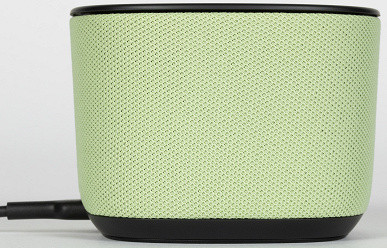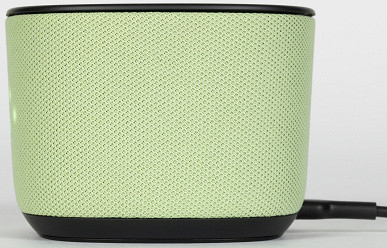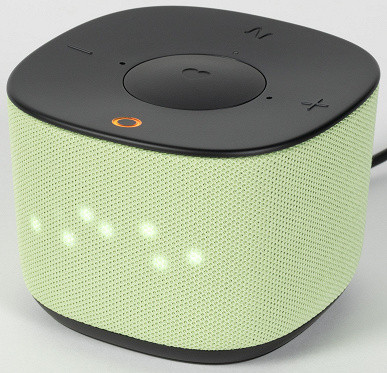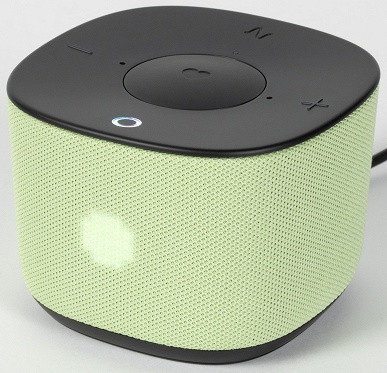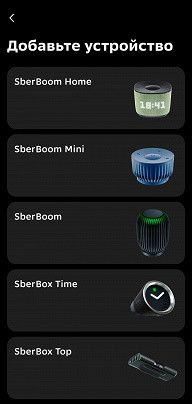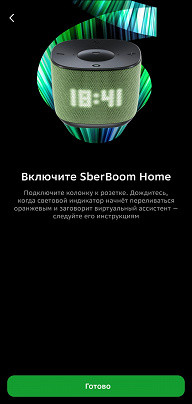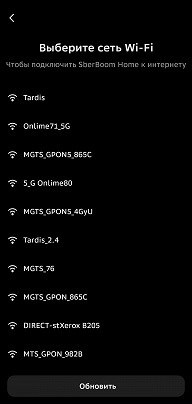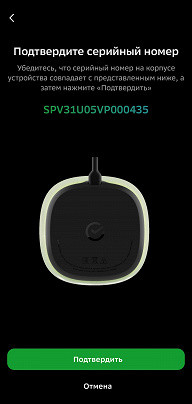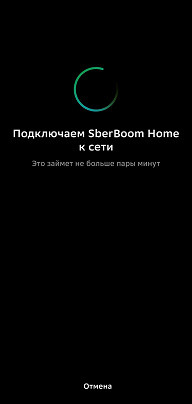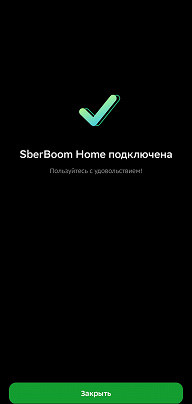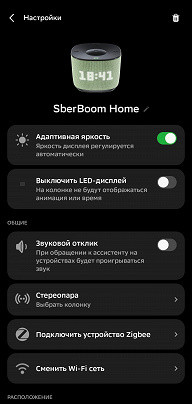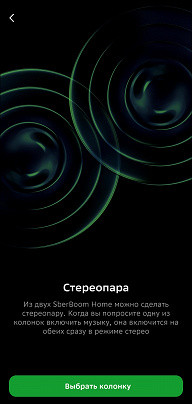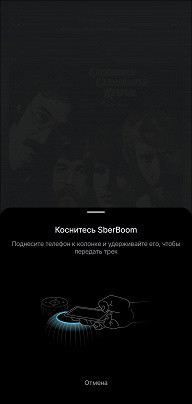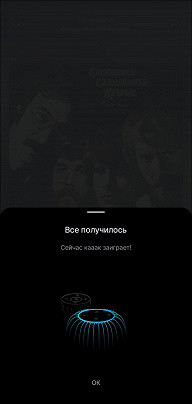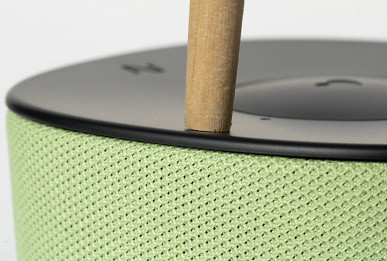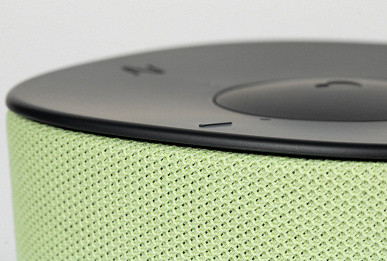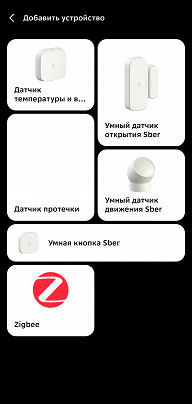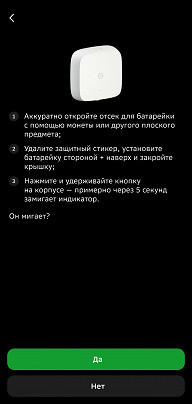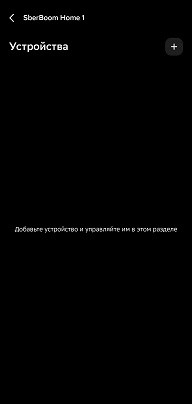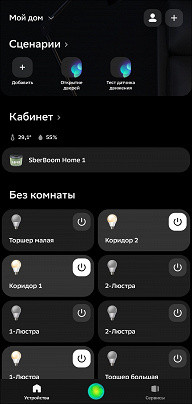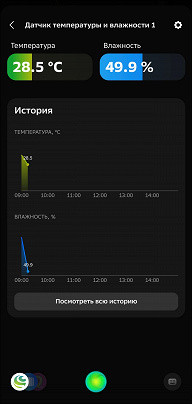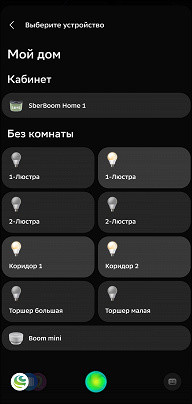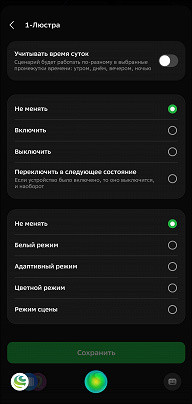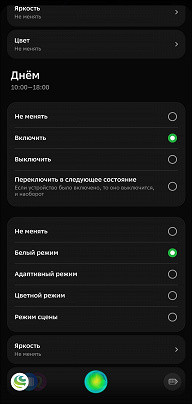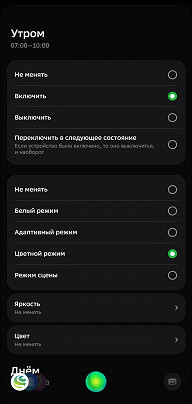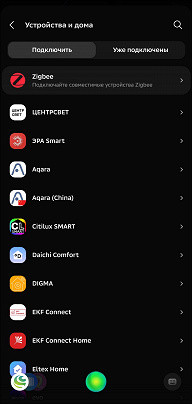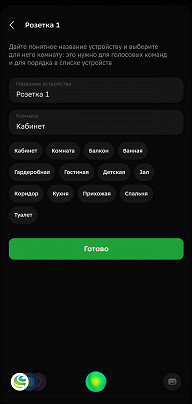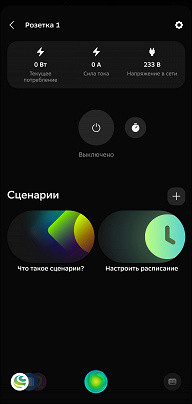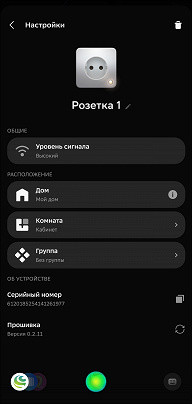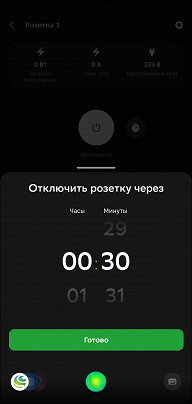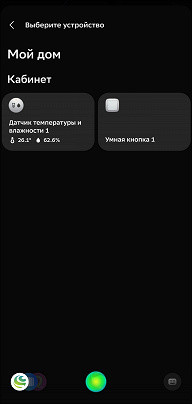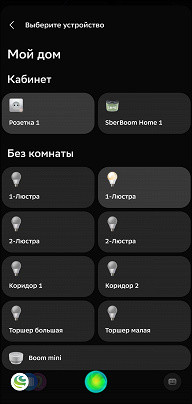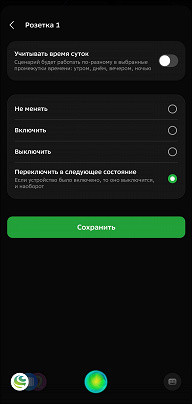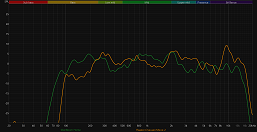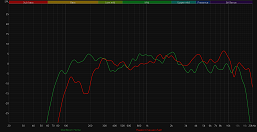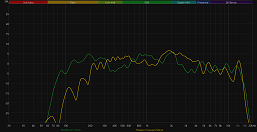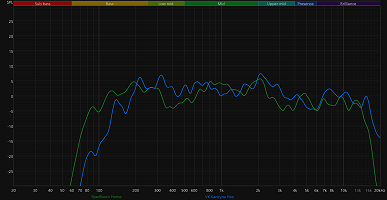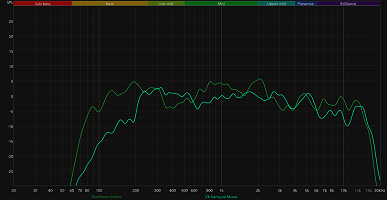Last year, Sber released two smart speakers: the large SberBoom and the small SberBoom Mini. Given the development of competing smart home systems, it was logical to expect an intermediate model with Zigbee protocol support, since previously, control of Sber's Zigbee devices required a special hub. These expectations were almost completely justified: the SberDevices team presented the SberBoom Home speaker, which became the first in the line with Zigbee support.
In terms of size and power, the new product is closer to compact solutions: it is only a centimeter higher than the SberBoom Mini, and the other dimensions and design of the top panel are almost identical. However, the power has increased, two passive emitters have been added to the broadband speaker, and a small display has appeared for the first time. As a result, SberBoom Home looks much more «advanced» compared to the younger model. The Mini version has also been updated: the SberBoom Mini 2 has been released, and we will definitely compare both versions in a separate review. In the meantime, let's focus on the new device and consider the new capabilities of Sber's smart home and the updated skills of the Salute voice assistant.
Technical specifications
| Power | 8 W |
|---|---|
| Emitters | a full-range speaker and two passive ones |
| Nutrition | 12V; 1.5A |
| Screen | monochrome LED matrix, 5×17 LEDs |
| Number of microphones | 2 |
| Wi-Fi | 2.4/5 GHz |
| Bluetooth | 5.0 |
| Zigbee | 3.0 |
| Dimensions | 92×92×67 mm |
| Weight* | 253 g |
* Based on our own measurements
Packaging and assembly
The speaker comes in a black cardboard box with bright illustrations and a brief description. At first glance, there are no changes — the packaging looks the same as the previous smart speakers of Sber.
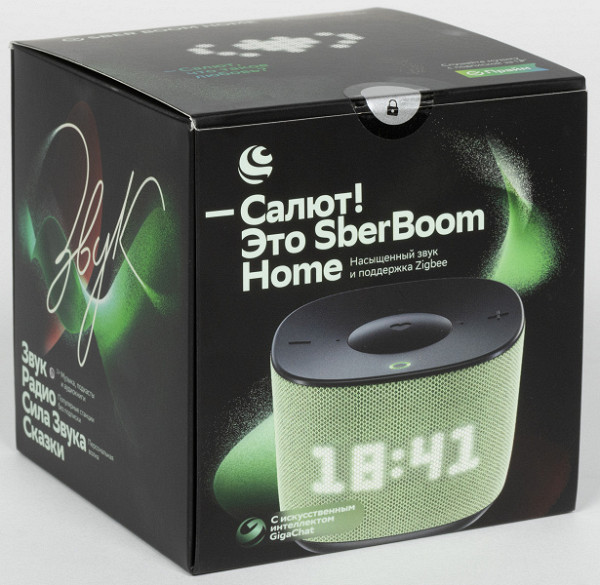
However, this is only at first glance. When unpacking, it becomes clear that the box opens in different directions, creating a kind of «pedestal» for the device, inside which are the rest of the components. The developers call this packaging «flower».
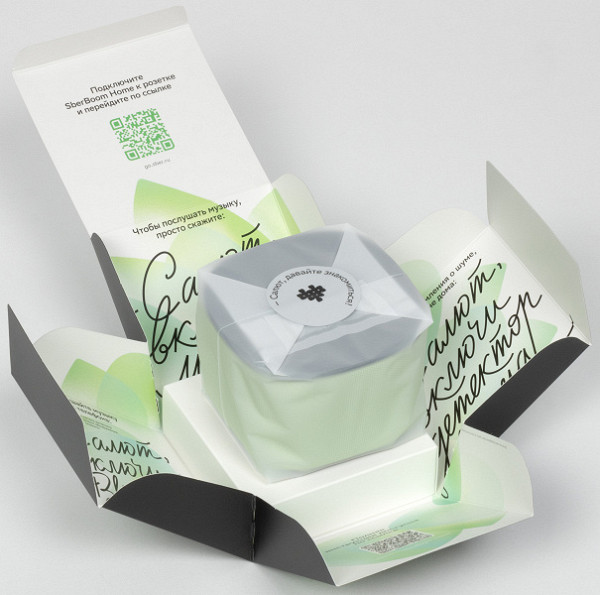
The box looks nice and original, and its use is very convenient — there is no need to make additional efforts to remove the speaker. Despite the lack of a tray to protect the device during transportation, you should not worry about its safety, as the plastic bag copes with the task quite well. On the inside of the package there is a brief instruction, as well as links and QR codes for access to a more detailed version of the instruction and the necessary software for the device.
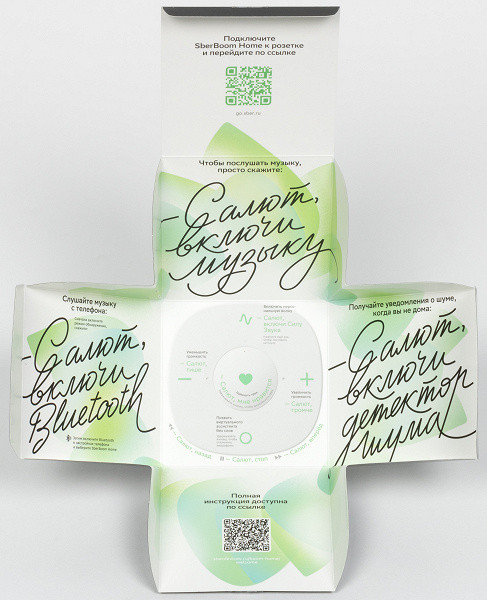
The package includes the SberBoom Home speaker itself, a power supply, a 1.5-meter cable with two USB Type C connectors at the ends, and documentation. In addition, it is possible to subscribe to SberPrime for a nominal fee of one ruble. As part of the subscription, the user gets access to the music streaming service «Zvuk», the Okko online cinema and other services. The creators of the device also provided options for use in «trial» mode without a subscription: new owners of the speakers can listen to recommended music for free for 10 hours, and fairy tales are available constantly. However, to fully use a smart speaker from any manufacturer, you will still need a subscription to its services, which is common practice.
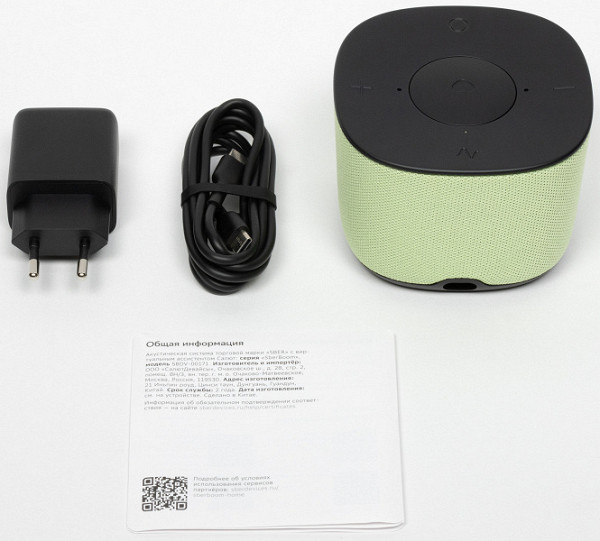
The cable is flexible, looks solid and inspires confidence in its reliability. If replacement is required, there will be no problems with this — there are plenty of cables with USB-C connectors in stores. Brief information about its characteristics is also indicated on the inside of the power supply.
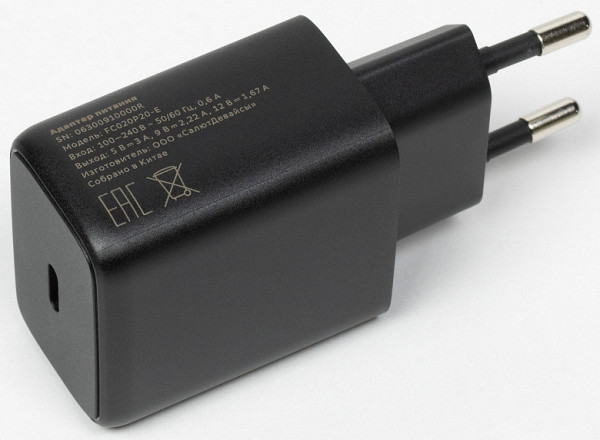
Design and construction
The speaker has an interesting and original design. Although it inherited some elements from the younger model, the new SberBoom Home looks much more attractive and solid. It will be available in five color options.
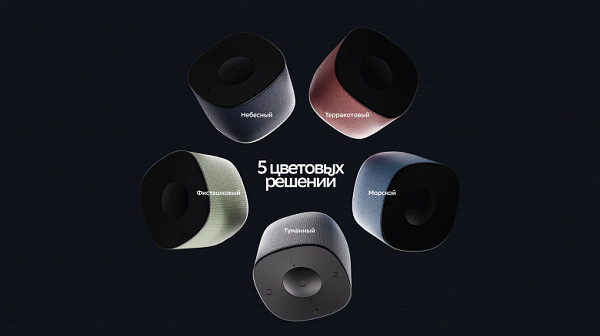
We had the pistachio version for testing. As mentioned above, the device is very compact: 92×92×67 mm.
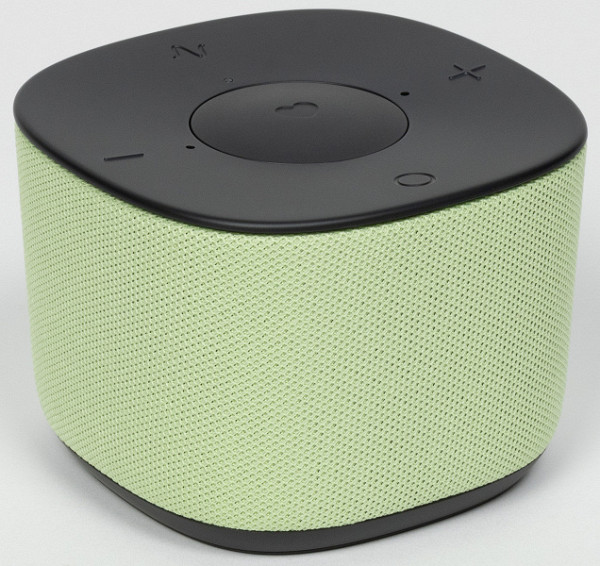
The entire side surface of the case is covered with a water-repellent fabric that is easy to clean. We have not conducted thorough tests, but we have checked the water-repellent properties — drops simply roll off the surface. Dust and other dirt are easily removed with a damp cloth.
The entire side surface of the case is covered with a water-repellent fabric that is easy to clean. We have not conducted thorough tests, but we have checked the water-repellent properties — drops simply roll off the surface. Dust and other dirt are easily removed with a damp cloth.
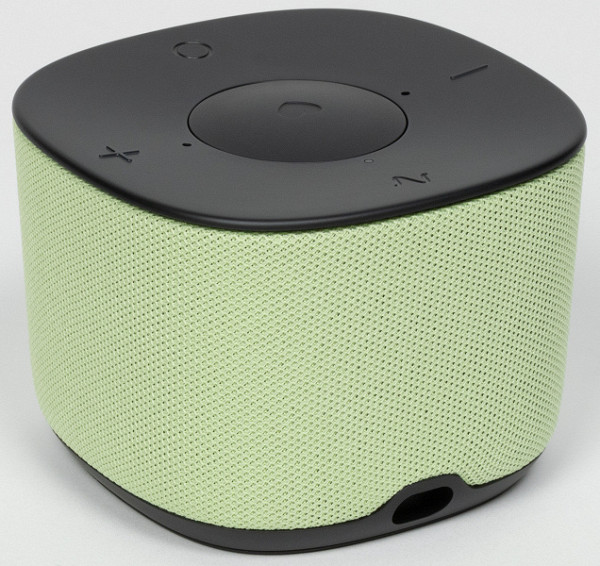
The USB Type C port for connecting the power cable is located at the bottom of the rear panel. A special recess around the connector ensures a tight hold of the plug and gives it a neater appearance.
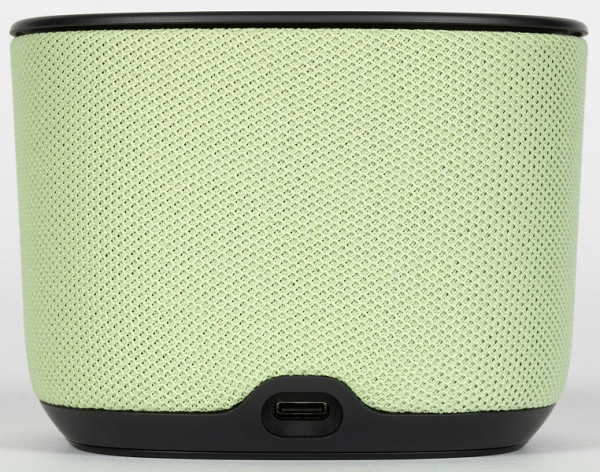
At the bottom of the panel is a small LED indicator that changes color depending on the operating mode of the device. Another key feature of the new speaker is a small display on the front of the case.
Unlike many competitors using segment indicators, SberDevices chose a monochrome LED matrix consisting of 5 rows of 17 LEDs. This significantly expands the possibilities for displaying information: in addition to the time and the assistant's «emotions», the SberBoom Home screen shows weather icons, an equalizer that «jumps» to the beat of the music, and the name of the track being played. There are many options for using the screen, and the developers do not exclude the possibility of providing access to third-party developers to create new «skills» for the voice assistant.
The display brightness is adjusted automatically, and changes occur quickly and at the right time, so that the speaker placed next to the bed will not disturb at night. If necessary, the brightness can be adjusted manually through the control software or the display can be turned off completely. On the bottom of the device there is a silicone pad with the manufacturer's logo, which ensures reliable placement of the speaker on a horizontal surface.
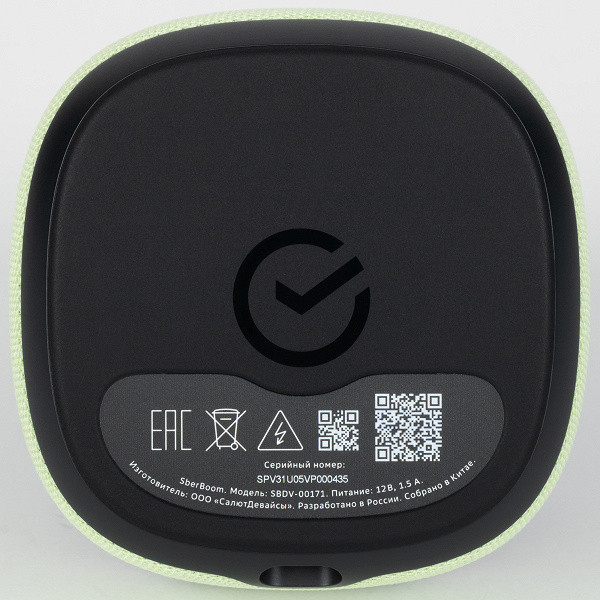
Connection and preparation for work
After power is supplied, the speaker speaks step-by-step instructions for voice activation — everything is very simple and clear. To connect SberBoom, you need to download the Salut! application for Android, iPhone owners will have to use the web application. We have already considered in detail the process of activating Sber's smart speakers, so today we will not go into details.
After connecting to the Wi-Fi network, the speaker will ask you to check and confirm the serial number, then spend some time authorizing and installing updates. In total, the entire connection process takes about 5 minutes.
For playing music and other content, it is more convenient to use the streaming service «Zvuk», since all Sber smart devices are integrated with its services that offer a subscription (a trial version is included in the kit). However, the SberBoom Home speaker also supports connection via Bluetooth — to activate pairing, just say: «Salute, turn on Bluetooth». Multipoint is not supported, and we traditionally checked the list of used codecs and their modes using the Bluetooth Tweaker utility.

The speaker supports only one codec – basic SBC, which is quite satisfactory for a small smart speaker. The maximum Bitpool value is set at 250, which is significantly higher than the recommended value of 51 for the High Quality profile. Thus, the codec will use its capabilities to the limit. The voice assistant continues to work effectively and recognize the user even when playing content via Bluetooth, maintaining access to all smart functions, including smart home control.
Operation and management
On the SberBoom Home control page, the user is asked to select its location, adjust the display brightness, and form a stereo pair with another similar speaker.
Recently, Sber's smart speakers have received several significant updates that have improved interaction with them. One of the main new features is the contractivization function: when the speaker responds to a command, it can block the response of other nearby devices. This means that if you say «Salute», only the speaker that is closer to you will respond, while the others will remain silent.
This function works great: in our testing, when two speakers were active in different rooms and even in different corners of the same room at a distance of 4-5 meters, only the one that was closer to the speaker worked. It also became possible to transfer messages between speakers: you can ask one speaker to call someone from the kitchen, and it will fulfill the request.
Another useful new feature is the transfer of playback from the Sound service from your smartphone to the speaker by touching the devices (using an NFC tag). This allows you to start listening to music outside and continue it on the speaker at home, simply by touching it.
The new device also offers other interesting features of Sber's smart speakers. For example, there is a noise detector, which we discussed in detail in one of our previous reviews.
You can control SberBoom Home not only with voice commands, but also with five buttons on the top panel. Two side buttons are used to adjust the volume, the bottom one is used to call the assistant. The top button launches the Sound Power function, which creates a playlist in the Sound service based on the user's preferences.
The central button allows you to like or dislike the track that is playing: a short press is a like, a long press is a dislike. It is located in a small recess and protrudes above the surface, which makes it easy to detect by touch. If the speaker is located nearby, you can conveniently set likes and dislikes to adapt the service's recommendations to your musical preferences. A couple of days of actively rating allows Sound to offer more interesting music for the user within its library.
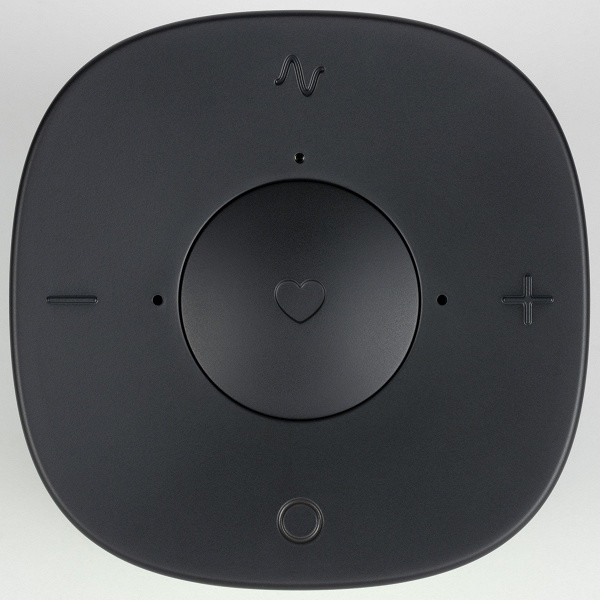
In fact, SberBoom is controlled in a not entirely traditional way. Instead of the usual buttons, the top panel is tilted in different directions. This turned out to be quite convenient: the panel moves only a millimeter when tilted, and the moment of operation is obvious thanks to a noticeable click.
The volume control symbols are slightly convex, which makes it easier to find them by touch. The central like button responds to pressing over the entire area, without requiring an exact hit in the center — it is enough to press even on the edge, although this will require a little more effort.
SberBoom Home has two microphones, just like the younger model in the line. They show good results in operation: despite loud music or noise in the room, such as a working hood or running water, the speaker successfully perceives commands. We did not find any false positives — the speaker did not launch the voice assistant without an explicit request or pressing a button, even when it was on the desktop for several days.
"Smart Home" and Voice Assistant Salute
In the comments to one of the previous SberBoom tests, someone noted that a smart speaker without built-in AI is not so “smart”. And now, less than a year later, the system has been updated to the GigaChat AI, which significantly expands the capabilities of the voice assistant. Now it can answer questions in detail, take into account the context and support a more natural conversation. GigaChat is also responsible for filtering obscene language in music, content for children and recognizing children's voices. The developers claim that recognizing children's voices has become much more accurate, although sometimes the AI can make mistakes, mistaking high-pitched female voices for children's — this is a problem that even people have.
Particular attention is paid to interaction with children: specialized “children's waves” with songs are now available, fairy tales can be listened to without a subscription, and you can also compose fairy tales together with the AI. This skill demonstrates the capabilities of GigaChat well — it remembers the names of the characters, logically fits in unexpected plot twists and offers its own solutions.
The Sber smart home system can integrate both the company's own devices and products from more than 30 third-party manufacturers. However, there is no support for popular Xiaomi devices yet, and this is unlikely to change in the near future. In the previous review, we looked in detail at connecting smart devices via Wi-Fi, including the pairing process, setup, and creating groups. Today, we will focus on the key function of the new speaker — support for the Zigbee protocol.
First, let's try to connect the temperature and humidity sensor, released under the Sber brand. To do this, we will start searching for devices on the speaker through a special menu in the Salut! application, and activate the connection mode on the sensor itself.
After a few minutes, the sensor is successfully connected, and all that remains is to select its location. Current readings and statistics are available on the device page. It is also worth noting that all devices added in previous tests were easily detected again by the system and became available for control without any additional actions on our part.
Now that we have a sensor, we can set up a scenario that uses its data as a trigger. There are two parameters available — temperature and humidity, and we will use both.
The scenario can be set to trigger based on a certain indicator being exceeded, a certain level falling below, or a precise value being reached — all of these options are taken into account. The «and/or» logic is especially pleasing, allowing you to combine several factors to activate the scenario. This is a long-awaited feature that we expected from other «smart home» ecosystems, but SberDevices implemented it faster.
For example, to automatically turn on the light in a room, you can use the following logic: the light should only turn on if a user enters the hallway and it is dark in the hallway. In this case, the motion sensor will be triggered, and the light sensor will check the light level. Thus, the light will only turn on if both conditions are met.
To demonstrate control based on temperature and humidity sensor data, we will use a light bulb, although in practice it would be more logical to control an air conditioner. As shown in the illustrations above, the light bulb turns on when the temperature or humidity rises above a set threshold.
You can also set up a scenario depending on the time of day: in our example, the light bulb will glow in different colors in the morning and in the afternoon. After setting up, simply save the scenario, and it will be activated immediately. Throughout the testing, the correct execution of scenarios did not cause any problems.
Now that we have a sensor from Sber, let's try connecting a device from another manufacturer. Although the Zigbee protocol promises compatibility, in practice this is not always the case, since devices may have nuances that affect their interaction. SberDevices initially announced support for more than 40 manufacturers for interaction with SberBoom Home, which opens up options for choice. We decided to test connecting a Zigbee socket from Aqara. We put the socket into pairing mode according to the instructions, start the search, and after a few seconds we receive an invitation to complete the setup.
We specify the location of the socket, and that's it — we go to its page. Here the current energy consumption, current strength, network voltage and other basic data are displayed. We saw similar information for the Sber socket. From the application, you can also quickly set up a shutdown timer, which is useful.
And finally, let's add the Sber button — we'll need it to test another important feature that the Zigbee smart home provides.
We add the simplest possible scenario that allows our button to control the outlet on and off. We press the button — everything works.
We turn off the Internet by simply unplugging the router from the socket. At the same time, the socket continues to respond to commands. This demonstrates the main advantage of Zigbee — devices can be controlled without connecting to a home network and the Internet, provided that both the controlling and controlled devices support this protocol. However, voice commands are not available in offline mode. The developers hint that they will appear in the future, but the exact dates are not yet known.
The voice assistant continues to support multi-commands: for example, you can say «turn off the lamp in the hallway, turn on the TV in the room and close the curtains» — all actions will be performed sequentially. This is the functionality that we have long been waiting for from other voice assistants, but have not even received an announcement yet.
Improved interaction with Sber TVs and the SberBox TV set-top box is also expected after the release of SberBoom Home. You can combine two speakers into a stereo pair, connect them to the TV and fully control the interface of both the built-in shell and third-party applications. In some applications, the system is integrated quite well, in others, minimal functionality is available — emulation of pressing the main keys. Sound content will be played through the speakers, which improves the perception of the assistant's commands even against a loud background.
Sound and frequency response measurements
Although SberBoom Home occupies an intermediate place in the line of Sber smart speakers, its dimensions are not much different from the most compact model, SberBoom Mini. Therefore, it is difficult to impose high demands on sound quality — the main task of the speaker is to comfortably interact with the voice assistant, voice fairy tales and sometimes play music in the background. To do this, it is enough to have a more or less balanced sound without noticeable distortion. In this context, we will consider the frequency response graphs.
When measuring the frequency response of compact acoustic systems, we usually carry out two series of measurements. We perform one of them by placing the measuring microphone at a distance of about 60 cm from the speaker and perpendicular to its side plane.
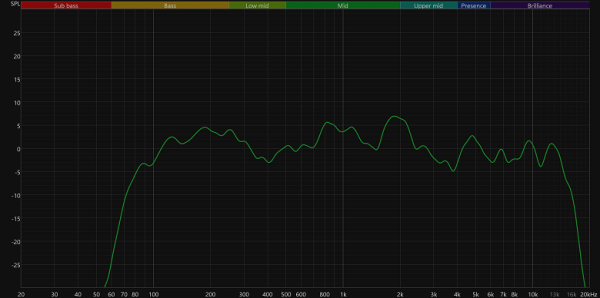
And the second is by moving the microphone upward and placing it at an angle of 45°, since such devices are often placed approximately at the level of the listener’s waist.
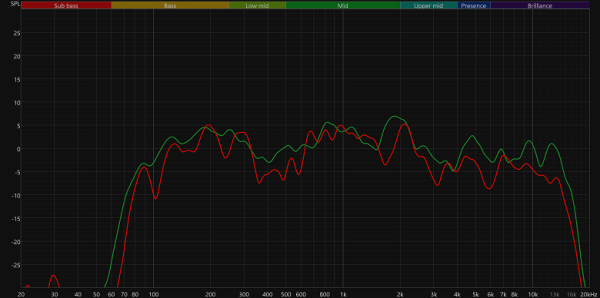
After averaging the graphs, we get an overall picture that is slightly better than expected. Low-frequency reproduction starts at 100 Hz, which is quite impressive for such a compact speaker. The midrange is not perfect, but is free of obvious distortion and generally sounds organic, while being slightly accentuated, which helps to better perceive voice commands. High frequencies are slightly muted to avoid excessive harshness — this is a reasonable decision that makes them clear enough, but at the same time not irritating or tiring to the ear.
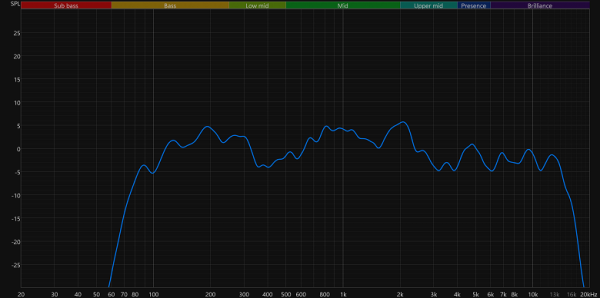
First, let's compare the new product with the already familiar SberBoom Mini (we'll talk about the second version separately). With an increase in size, the new product demonstrates a deeper and richer sound in the low-frequency range, and the high frequencies become more voluminous and pleasant. As a result, SberBoom Home clearly surpasses SberBoom Mini in sound quality.

All three compact Yandex speakers are noticeably inferior in low frequency reproduction. However, it is worth considering that their dimensions are significantly smaller, and for their dimensions they demonstrate quite decent sound quality.
It is interesting to compare SberBoom Home with Yandex Station Midi, which is in the middle price segment among Yandex speakers and also supports Zigbee. Despite the difference in size — Station Midi is noticeably larger — it is difficult to single out a clear leader in sound quality. Sber's speaker focuses on the midrange, while Station Midi offers a more distinct high-frequency register. Here the choice depends on personal preferences.
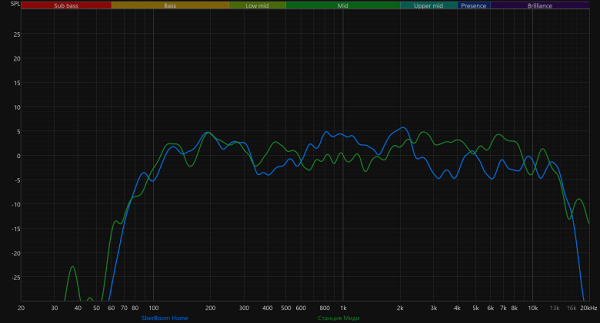
Another popular series of speakers is VK. Compared to the Neo Capsule, SberBoom Home demonstrates almost parity, although the bass quality is still different. The Mini Capsule, in turn, is inferior to SberBoom Home in both bass and high-frequency register. However, it should be remembered that both of these speakers are smaller in size. There are no smart speakers of a similar size to SberBoom Home on the market yet, which makes it unique in its category. In any case, for its size, the new speaker demonstrates excellent sound quality and copes well with the given scenarios.
Results
We expect a compact smart speaker to perform four main tasks: to become a control center for a smart home, to provide interaction with a voice assistant, to play music in the background, and to entertain children. The new SberBoom Home copes with all these tasks perfectly. In terms of sound quality, it even exceeds expectations, demonstrating noticeably better sound compared to other smart speakers of similar sizes.
The development of the smart home from Sber is pleasing, since all SberBoom models provide full access to functions such as a noise sensor, multi-commands with “and/or” logic, work with GigaChat AI, various entertainment functions for children, and content filtering systems.
SberBoom Home inherited from the younger model a control panel for likes and playing personalized playlists, an informative screen and Zigbee support were added, which eliminates the need for an additional hub.
The price of the new product is quite attractive: at the start of sales, it is offered in pistachio and sea colors for 8 thousand rubles, including a temperature and humidity sensor as a gift. For comparison, Yandex.Station Midi with slightly larger dimensions, comparable sound quality and Zigbee support costs about 16 thousand rubles. It is becoming increasingly difficult to determine the clear leader in the quality of the voice assistant and the convenience of the «smart home», since Sber has GigaChat AI, support for multi-commands and other interesting functions. This indicates that SberDevices, which began their work later, are not only catching up with their competitor, but are also close to their level, despite the smaller number of users.

